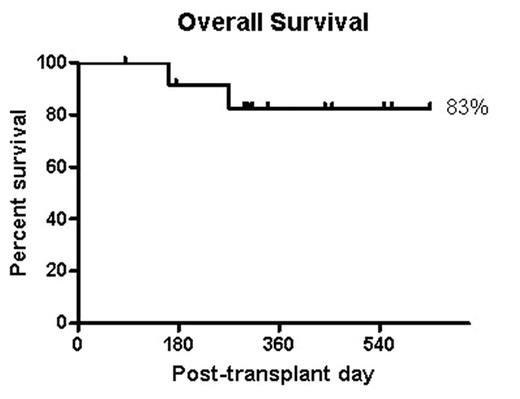Abstract
The administration of alemtuzumab (Campath 1H) as part of the conditioning regimen prior to allogeneic stem cell transplantation (ASCT) results in a low incidence of acute and chronic GVHD. However, intravenous Campath administration is also associated with significant infusional toxicities and a higher risk of infectious complications post-transplant. We evaluated the role of low-dose subcutaneous Campath prior to unrelated donor ASCT in 13 patients deemed to be at high risk for mortality (age>40years, significant comorbidity, or prior autologous transplant). Median age of transplant recipients was 54 (37–61) years and three patients had a prior autograft. Diseases included secondary/poor risk AML-5, CML-1, MPS-2, relapsed HD-1, NHL-3, and CLL-1. The preparative regimen consisted of fludarabine and targeted oral busulfan (myeloid malignancies) or cytoxan±rituximab (lymphoid malignancies). Campath was administered subcutaneously from d-5 to d-3 at a total dose of 43mg. Low dose Campath was well tolerated with no untoward toxicity. Early mixed T cell chimerism generally occurred (median day +100 donor CD3 60% (8–100) and CD33 100% (67–100)), requiring door lymphocyte infusion (DLI) in 10 of 13 patients. Ten of 11 evaluable patients achieved complete donor chimerism at a median of 112 days (32–260), and no graft failures have occurred. Acute graft-versus-host disease (GVHD) occurred in 5/13 patients (38%) at median day +58 (23–152) (grade I[1] and II[4]). Chronic GVHD occurred in 6/12 evaluable patients (3 limited, 3 extensive) and no GVHD mortality has occurred. CMV reactivation occurred in 5 of 9 at-risk patients (55%) with a median day to reactivation of day +25 (9–38), median number of reactivations of 2 (1–4), but no CMV disease or mortality. After a median follow-up of 340 (84–631) days, eleven of thirteen patients survive for a one year actuarial survival of 83%. No patient has died from treatment-related mortality. Relapse occurred in 5/13 patients resulting in the death of two patients. Low dose subcutaneous campath administered during conditioning results in low TRM and promising survival in older high risk patients undergoing unrelated donor ASCT.
Author notes
Disclosure:Off Label Use: Off-label use of Campath in conditioning for allogeneic hematopoietic stem cell transplantation.


This feature is available to Subscribers Only
Sign In or Create an Account Close Modal